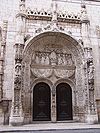
Vila Franca do Campo is a town and municipality in the southern part of the island of São Miguel in the Portuguese Autonomous Region of the Azores. The population of the municipality was 11,229 in 2011, in an area of 77.97 km². The town proper, which incorporates the urbanized parishes São Miguel and São Pedro, has 4100 inhabitants.

Azulejo is a form of Portuguese and Spanish painted tin-glazed ceramic tilework. Azulejos are found on the interior and exterior of churches, palaces, ordinary houses, schools, and nowadays, restaurants, bars and even railways or subway stations. They are an ornamental art form, but also had a specific functional capacity like temperature control in homes.

Leonor Teles was queen consort of Portugal by marriage to King Ferdinand I, and one of the protagonists, along with her brothers and her daughter Beatrice, of the events that led to the succession crisis of 1383–1385, which culminated in the defeat of her son-in-law King John I of Castile and his armies in the Battle of Aljubarrota. Called "the Treacherous" by her subjects, who execrated her on account of her adultery and treason to her native country, she was dubbed by the historian Alexandre Herculano as "the Portuguese Lucrezia Borgia".
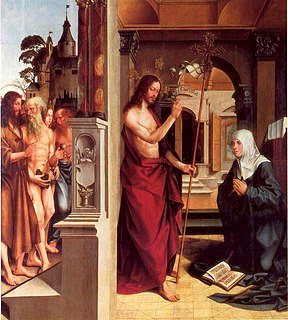
Jorge Afonso was an important Portuguese Renaissance painter.

Cristóvão Lopes (c.1516–1594) was a Portuguese painter.

The Church of São Lourenço is a Church in the civil parish of Almancil, in the municipality of Loulé in the Portuguese Algarve.

Gilded woodcarving in Portugal is, along with tile, one of the country's most original and rich artistic expressions. It is usually used in the interior decoration of churches and cathedrals and of noble halls in palaces and large public buildings. An impressive collection of altarpieces are found in Portuguese churches. Originating in the Gothic era, Portuguese gilded woodcarving assumed a nationalist character during the 17th century and reached its height in the reign of King D. João V. In the 19th century it lost its originality and began to disappear with the end of the revival era.
João Antunes (1642–1712) was a Portuguese architect and master mason, considered to be one of the most important architects of Baroque architecture. Antunes served as royal architect during the reign of King Pedro II of Portugal and is responsible a number of famous landmarks in Lisbon, such as the National Pantheon at Santa Engrácia, and the tomb of Saint Joana, Princess of Portugal.
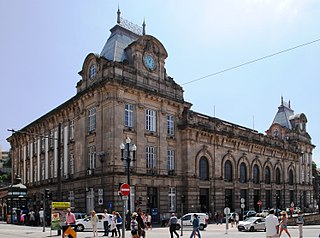
São Bento Railway Station is a 20th-century railway terminal in the civil parish of Cedofeita, Santo Ildefonso, Sé, Miragaia, São Nicolau e Vitória, in the municipality of Porto, district of Porto. The English translation of São Bento is Saint Benedict. The station is located in the Historic Centre of Porto, which has been declared a UNESCO World Heritage Site and as a National Monument of Portugal.
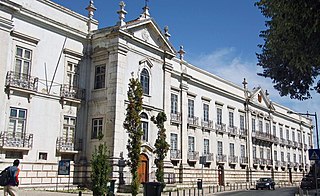
Penha de França is a freguesia and typical quarter of Lisbon, the capital of Portugal. Located in the historic center of Lisbon, Penha de França is east of São Vicente, south of Arroios and Areeiro, and west of Beato. The population in 2011 was 27,967,

Manor of Madre de Deus is a historic former residence of the Bettencourt family in the civil parish of Sé, in the municipality of Angra do Heroísmo, in the Portuguese archipelago of the Azores.
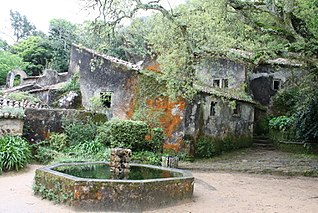
The Convent of the Friars Minor Capuchin, popularly known as the Convent of the Capuchos, but officially the Convento de Santa Cruz da Serra da Sintra, is a historical convent consisting of small quarters and public spaces located in the civil parish of São Pedro de Penaferrim, in the municipality of Sintra. Its creation was associated with the Portuguese Viceroy of India, D. João de Castro, and his family, but became a pious community of reclusive clergy that continued to occupy cramp humble spaces in the complex, until the religious orders were abolished in Portugal.
The Church of the Lóios is a 15th church civil parish of Évora, municipality of Évora, in the Portuguese Alentejo.

The Museu Nacional do Azulejo, occasionally known in English as the National Tile Museum, is an art museum in Lisbon, Portugal dedicated to the azulejo, traditional tilework of Portugal and the former Portuguese Empire, as well as of other Iberophone cultures. Housed in the former Madre de Deus Convent, the museum's collection is one of the largest of ceramics in the world.

Torrão is a civil parish and town, in the municipality of Alcácer do Sal, in the Portuguese district of Setúbal, bordering on the districts of Évora and the Beja. It is crossed by the river Xarrama River. The population in 2011 was 2,295, in an area of 372.39 km².

The Convent of Caloura is a Portuguese 16th-century convent located in the civil parish of Água de Pau, in the municipality of Lagoa, on the island of São Miguel in the archipelago of the Azores.
Madre de Deus is Portuguese for Mother of God, a Christian title for Mary, mother of Jesus. In English it may refer to:

The Convent of Beato António is a former Portuguese convent, located in the civil parish of Beato, in the municipality of Lisbon.

A Church of São João Evangelista, or Carmelite Church of Aveiro, is an 18th-century church in the Praça Marquês de Pombal, in the civil parish of Glória e Vera Cruz, in the Portuguese municipality of Aveiro. It was declared a national monument in 1910.

The Convent of Santo António da Cidade is a former-convent and public library in the civil parish of Bonfim, in the municipality of Porto, in the Portuguese district of the same name.


















